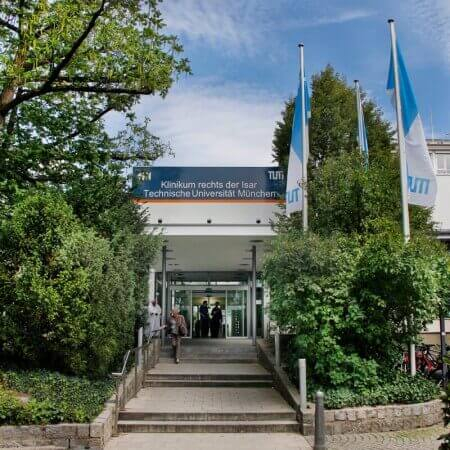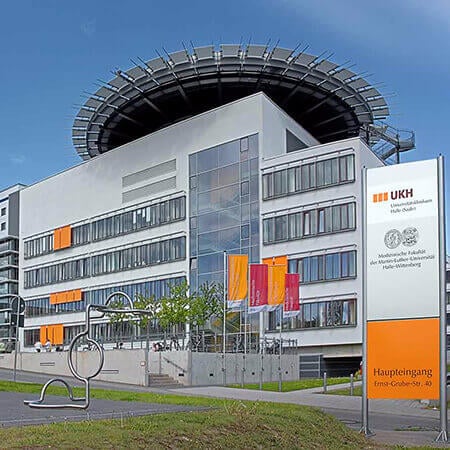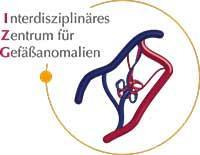Ovarian Cancer — Embolization or Chemoembolization: treatment in the Best Hospitals in the World
Treatment prices are regulated by national law of the corresponding countries, but can also include additional hospital coefficients. In order to receive the individual cost calculation, please send us the request and medical records.

Department of Interventional Radiology
The Department of Interventional Radiology offers the full range of imaging examinations, as well as innovative image-guided minimally invasive techniques for the treatment of tumors, vascular diseases and internal pathologies (for example, CT, MRI, PET-CT, SPECT). The department's doctors have deep knowledge and colossal experience in the field of interventional radiological methods of treatment, which represent an excellent alternative to open surgical interventions. Despite the high level of technical equipment and the presence of advanced computerized systems, the focus is always on the person with his individual needs. Compliance with current clinical protocols and high professionalism of the department's specialists contribute to the successful clinical practice, as well as the reputability of the department among the best medical facilities of this kind in Germany.




Department of Interventional Radiology and Neuroradiology
The Department of Interventional Radiology and Neuroradiology offers a full range of advanced imaging diagnostics and minimally invasive treatments on both an inpatient and outpatient basis. The department has state-of-the-art medical equipment for imaging tests such as X-ray, computed tomography, magnetic resonance imaging, digital subtraction angiography, and mammography. The medical facility also performs many highly effective interventional therapeutic procedures under image guidance, which in many cases allow patients to avoid traumatic open surgery. For example, the department successfully performs local fibrinolysis, thrombectomy, percutaneous transluminal angioplasty, hemostasis, transarterial chemoembolization, uterine artery embolization, and other procedures. The department's neuroradiologists specialize in brain and spinal cord imaging and the treatment of central nervous system disorders. Interventional neuroradiology focuses on the treatment of carotid artery stenosis, brain aneurysms, arteriovenous malformations, dural fistulas, subdural hematomas, brain tumors, skull base and spinal tumors, and chronic back pain. The department's medical team has extensive clinical experience in their areas of expertise. The specialists are guided by the recommendations of the German Society for Interventional Radiology and Minimally Invasive Therapy (DeGIR) and the German Society for Neuroradiology (DGNR), which helps to achieve the best results.






Department of Adult and Pediatric Diagnostic, Interventional Radiology, Neuroradiology
The Department of Adult and Pediatric Diagnostic, Interventional Radiology, Neuroradiology is one of the best institutions of its kind in Germany and offers patients the full range of radiological studies and imaging-guided minimally invasive therapy. The department’s scope of tasks also includes imaging diagnostics in children of all age groups, detection and invasive treatment of cerebral vascular pathology (neuroradiology). Patient care is provided both on an inpatient and outpatient basis.






Ovarian cancer is the second most common malignant tumor after breast cancer in women between the ages of 50 and 60. In two cases out of three, the disease is diagnosed at stages 3 or 4, when the tumor has spread along the peritoneum or given distant metastases. The main treatment for ovarian cancer at any stage is surgery. Chemotherapy can also be used. With liver metastases detected, doctors in European clinics use chemoembolization.
Content
- What are embolization and chemoembolization
- Treatment principles for ovarian cancer
- When is embolization used
- Embolization in the combination treatment of ovarian cancer
- How is embolization performed
- Why is it worth undergoing embolization in European hospitals
- Treatment in European hospitals with Booking Health at an affordable price
What are embolization and chemoembolization
Embolization is a treatment method in oncology, which allows the doctors to suppress malignant tumors by closing the lumen of the arteries supplying them.
To divide quickly, cancer cells need a lot of blood, which brings energy and oxygen. Therefore, the cancer tumor quickly overgrows with blood vessels. If these blood vessels are closed, the part of the tumor, which no longer receives blood, quickly dies off.
Embolization is more often used not in its pure form, but in combination with regional chemotherapy. In this case, the treatment is called chemoembolization. As a rule, chemotherapy drugs are included in the emboli, which doctors use to block arteries. Sometimes these procedures are carried out simultaneously, but independently of each other: doctors simply infuse chemotherapy drugs into an artery, and then block these vessels with emboli.
The treatment procedure is minimally invasive. The vessels are usually accessed through a small incision in the leg. The doctor performs femoral artery catheterization. It is also possible to gain access through the brachial, axillary, and radial arteries. To control the procedure, doctors perform contrast-enhanced X-ray scanning.
There are dozens of types of embolic agents that can be used to close the vessels. Doctors use solids, alcohols, glue, spirals, etc. Lipiodol emulsion with chemotherapy drugs or drug-eluting microspheres is most often used for chemoembolization.
Embolization is a sparing, minimally traumatic and patient-safe method of cancer treatment. When performed correctly, the procedure rarely causes complications. It reduces the size of the tumor by several times. If the cancer recurs or progresses, embolization can be repeated.
Treatment principles for ovarian cancer
The main treatment option for ovarian cancer is surgery. Whenever possible, doctors try to perform complete cytoreduction. The procedure aims to remove the uterus with appendages and all tumor foci, most of which are located in the abdominal cavity.
At stages 1-2, the doctor may try to cure the disease. He performs procedures for the surgical staging of ovarian cancer: he takes tissue samples from the abdominal cavity, and receives a lavage. Should the stage be confirmed, the regional lymph nodes will be removed in order to reduce the risk of cancer recurrence.
At 3-4 stages of ovarian cancer, surgical procedures are also performed. However, cancer is not expected to be cured, so doctors do not remove lymph nodes, except the enlarged ones due to the oncological process. Such an approach allows the doctors to reduce the invasiveness of the operation, to reduce the number of complications, without worsening the survival rates of patients. To control cancer after surgery, systemic drug therapy can be used. Metastatic foci are suppressed with radiation therapy, ablation, and chemoembolization.
The second most important treatment for ovarian cancer is chemotherapy. In the vast majority of cases, it is carried out after the operation, and sometimes chemotherapy can be initiated even prior to surgery. At the advanced stage of the disease, chemotherapy becomes the main treatment method.
Clinics abroad use not only standard, but also innovative treatment methods for ovarian cancer, including:
- Hyperthermic intraperitoneal chemotherapy – washing the abdominal cavity with a warmed solution of cytostatics.
- Targeted therapy – angiogenesis inhibitors, PARP inhibitors.
When is embolization used
Embolization is not used to destroy the primary tumor located in the ovary, but it is performed to suppress metastases that most often affect the liver.
Regardless of the location of the primary neoplasm, approximately every third cancer patient has metastatic foci in the liver. This is due to the fact that a large amount of blood, both venous and arterial, passes through this organ. Most metastases are of hematogenous origin – they enter the liver through the blood. In case of ovarian cancer, tumor cells can also be disseminated through the peritoneum. Some of them settle in the area of the liver, increase in size and germinate the liver capsule, penetrating into the parenchyma of the organ.
With metastases found only in the liver capsule, ovarian cancer is classified as stage III. This is due to the fact that such metastatic foci are intra-abdominal. However, when metastatic foci develop in the liver parenchyma, stage IV is diagnosed.
Controlling metastases is just as important as controlling the primary tumor. Without treatment, patients with metastatic liver disease live an average of 12 months. The five-year survival rate is close to zero. Nonetheless, the use of chemoembolization in combination with other treatment methods, even at stage 4 ovarian cancer, allows the doctors to obtain good results: a third of patients live more than 5 years after diagnosis.
Embolization in the combination treatment of ovarian cancer
Hepatic artery chemoembolization is usually performed not as an independent procedure, but as an addition to cytoreductive surgery. It is also combined with other treatment methods for ovarian cancer.
The main treatment option at any stage is surgery, even at the fourth one. The doctor can remove the uterus with appendages and all tumor foci in the abdominal cavity. Liver resection is also performed as part of a combination surgery, if possible. However, this operation is complex and unsafe. It can only be performed in a small number of patients.
For most women, the primary treatment for ovarian cancer is cytoreductive surgery, sometimes supplemented with intraperitoneal chemotherapy, followed by chemoembolization to suppress liver metastases. The technique is combined with systemic drug therapy.
Some women cannot receive surgical treatment due to advanced stages of cancer or medical contraindications for surgery. Such patients receive systemic chemotherapy, targeted therapy, sometimes radiation therapy, and hepatic artery chemoembolization for liver metastases.
The procedure is safe, and therefore it can be performed even for debilitated patients. The liver is not significantly affected by this procedure. This is due to its dual blood supply: the healthy parenchyma receives 75% of its blood from the portal vein, and only 25% from the hepatic artery. At the same time, metastases of ovarian cancer are supplied by arterial blood for 90%. Therefore, when the lumen of the hepatic artery is closed, cancer cells die quickly, but liver failure does not develop after the procedure.
How is embolization performed
Hepatic artery chemoembolization is a minimally invasive X-ray-guided surgical procedure. The doctor usually inserts the catheter into large arteries through an incision in the leg. Then it reaches the hepatic artery. To assess the structure of the vascular bed, angiography is performed before the procedure – a contrast agent is injected into the arteries, and then a series of X-rays are taken to assess where and through which vessels arterial blood flows.
Accurate diagnostics helps the doctor make the following important decisions:
- From what sources the tumor receives most of the blood.
- Into which vessels emboli should be injected.
- Whether any vessels need protection so that the embolic agent does not enter them (to prevent complications caused by the closure of non-target vessels).
Oily chemoembolization is the most commonly used type of this procedure. An emulsion of lipiodol is injected into the hepatic artery. It penetrates deep into the parenchyma and blocks small vessels. Chemotherapy drugs stay in the liver for a long time, damaging the metastases of ovarian cancer. The procedure causes a temporary closure of the vascular lumen. After a while, it can be repeated if the cancer progresses.
Clinics in Europe often use chemoembolization with drug-eluting microspheres. These are tiny balls, which are saturated with cytostatics. They are injected into the branches of the hepatic artery. Microspheres enter small vessels and block them permanently. As a result, the blood supply to the metastases is irreversibly impaired. In addition, cancer cells die due to prolonged exposure to chemotherapy.
Trials show that microspheres are more effective than oily chemoembolization. They provide a higher response rate with less toxicity caused by regional chemotherapy. Cytostatics are released from microspheres for a longer time, which, on the one hand, promotes effective tumor suppression, and on the other hand, reduces the number and severity of systemic side effects.
Why is it worth undergoing embolization in European hospitals
Not every hospital uses embolization and chemoembolization for cancer treatment. Perhaps there is no hospital in your country that can offer this procedure at all, or the number of such hospitals is small. For the procedure to be successful, it is important for the clinic to have state-of-the-art equipment and doctors with vast experience in artery embolization. To successfully treat ovarian cancer with a combination of different methods, the hospital must lead interdisciplinary collaboration.
All these conditions are provided in clinics in the countries with developed medicine. You can go to Europe for ovarian cancer treatment. We will find the best clinic for you, in which doctors have vast experience in chemoembolization for this disease. There are several reasons why you should undergo treatment in European hospitals:
- Superselective embolization can be performed – doctors working in the European hospitals inject emboli as close to the tumor as possible in order to minimize damage to the healthy liver parenchyma.
- The use of modern types of chemoembolization, including drug-eluting microspheres.
- Whenever required, non-target vessels are closed with spirals or a balloon catheter to avoid the penetration of embolic agents into them and the development of complications.
- Embolization in European clinics can be performed through a radial approach (an incision in the arm). In this case, the risk of complications in the area of vessel puncture is reduced and there is no need for strict bed rest on the first day after the procedure.
- High-quality supportive and symptomatic treatment in the case of development of postembolization syndrome.
- European hospitals successfully combine embolization for the treatment of the disease with other treatment methods: surgery, hyperthermic intraperitoneal chemotherapy, targeted therapy, radiation therapy, and systemic chemotherapy.
You can take advantage of all the benefits of European medicine by contacting one of the European clinics. The treatment in countries with advanced medicine will be more effective, safer and more comfortable. The best clinics in the world provide their patients with the highest level of medical services.
Treatment in European hospitals with Booking Health at an affordable price
To undergo treatment in one of the European hospitals, please use the services of Booking Health. On our website, you can see the cost of treatment in different hospitals, compare prices and book a medical care program at an affordable price. The cost of embolization or chemoembolization for ovarian cancer is between 24,650 EUR and 41,400 EUR. The artery embolization procedure in a European hospital will be easier and faster for you, and the cost of treatment will be lower.
Please leave your request on our website. Our employee will contact you and provide consultation about the treatment in Europe. Booking Health will take care of the organization of your trip. We will provide the following benefits for you:
- We will select a hospital for treatment in Europe, whose doctors specialize in the treatment of ovarian cancer using the artery embolization procedure.
- We will help you overcome the language barrier, establish communication with your attending physician.
- We will reduce the waiting period for the medical care program and book a doctor's appointment on the most suitable dates.
- We will reduce the price. The cost of treatment in European hospitals will be decreased due to the lack of coefficients for foreign patients.
- We will take care of all organizational issues: documents for entering the country, transfer from the airport, hotel, interpreting services, etc.
- We will prepare a medical care program and translate medical records. You do not have to undergo previously performed diagnostic procedures.
- We will provide communication with the hospital after treatment in Europe.
- We will organize additional examinations and treatment in European hospitals, if necessary.
- We will buy medicines abroad and forward them to your native country.
- We will help you keep in touch with the hospital and the attending physician after treatment in Europe.
You will receive treatment from the best doctors in the world. The Booking Health specialists will help you reduce the cost of treatment and take care of all organizational issues, and you will only have to focus on restoring your health.
Authors: Dr. Vadim Zhiliuk, Dr. Sergey Pashchenko

